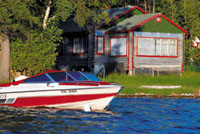Sigma 28 to 200mm f3.5 to 5.6 and 28 to 300mm f3.5 to 6.3
New Compact Hyper Zoom Aspherical Macro Lenses
Sigma makes numerous lenses,
but the "all-purpose" zooms have been the best selling models
in their vast line. Replacing the "DL Hyper Zoom" models,
the new 28-200mm and 28-300mm lenses are designated as "Compact
Hyper Zoom Macro." This suggests a significant downsizing and
the new lenses are certainly smaller and lighter than their predecessors.
As a bonus they offer two other advantages: closer focusing and a superior
optical formula that improves overall image quality. |
|||
Lens Features |
|||
28-200mm Compact Hyper Zoom Evaluation |
|||
As with most all-purpose zooms, I found noticeable barrel distortion (bowing outward of lines near the edge of the frame) at short focal lengths. At long zoom settings, pincushion distortion (bowing inward of lines) was noticeable. Frankly, this would be relevant only in formal architectural photography, not a typical use for a lens of this type. I noticed some light falloff (slight darkening of the corners of my slides) at wide apertures, when a polarized sky filled the frame. This is also common with wide range zooms. With this model, it may be caused by the narrower diameter of the front element. However, I applaud the designers for the smaller size because the lens accepts 62mm filters, instead of the more expensive 72mm size like its predecessor. Autofocus Evaluation |
|||
The Bottom Line 28-300mm Compact Hyper Zoom
Autofocus Evaluation Evaluation The Bottom Line Final Assessment |
|||
Sigma 28-200mm f/3.5-5.6 Angle Of View: 75.4 to 12.3Þ Maximum Aperture: f/3.5-5.6 Construction: 16 elements in 14 groups Minimum Focus Distance: 18.8" Maximum Magnification: 1:3.8 Filter Size: 62mm Dimensions: 2.75x2.96" Weight: 13.4 oz AF Mounts: Canon, Minolta D, Nikon D, Sigma SA Street Price: $249 |
|||
Sigma 28-300mm f/3.5-6.3 |








































